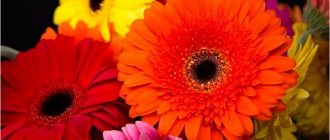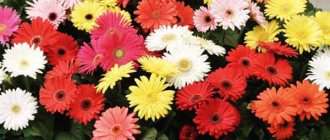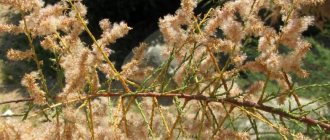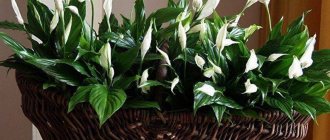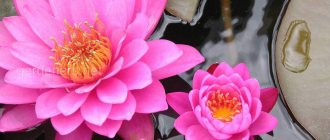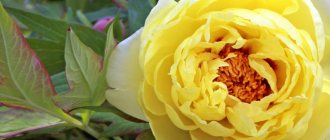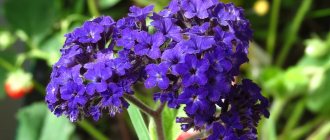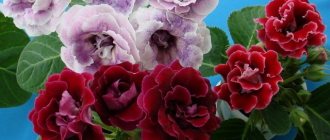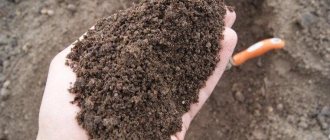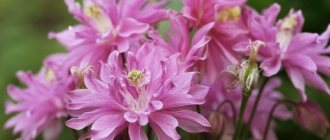In the language of flowers, gerbera means happiness, joy and openness - therefore, a bright, but at the same time striking in its simplicity, the flower was able to win the hearts of many fans. The South American beauty, which is also called the Transvaal (Madagascar) chamomile, attracts not only its appearance and romanticized image, but also the number of varieties, reaching about 80. At least 1000 varieties have been bred from them, differing in color, size and shape.
Gerbera is one of the most recognizable flowers
What do gerbera flowers look like?
Gerbera is one of the most recognizable flowers after roses, lilies and tulips. This plant was introduced into cultivation in the nineteenth century: the first variety that gave rise to all cultivated varieties was Jameson's gerbera. This is a rather large perennial herbaceous plant belonging to the Asteraceae, or Asteraceae, family.
You've probably noticed bright baskets in bouquets, reminiscent of the sun or multi-colored daisies - most likely it was a guest from Madagascar. Characteristic external features are a thick long stem, dark green oblong leaves collected in a basal rosette and inflorescences of rich colors in the shape of baskets, reaching a diameter of 10 cm.
Gerbera in a bouquet or in a pot is a beautiful, symbolic and even useful gift
The structure of inflorescences, mistakenly taken for one flower, is not as simple as it seems at first glance. The fact is that the “basket” is not just one flower. It consists of petals, which are full-fledged, independent flowers, arranged in several rows. There are varieties with both regular inflorescences and double ones, more like asters. The core is also formed by many independent small tubular flowers with a variety of colors.
Depending on the properties of the inflorescences, all varieties are divided into six large groups. The shape of the petals (narrow, wide), the size of the inflorescence itself and the “doubleness” are taken into account. Each of the varieties grown today is a product resulting from work with Madagascar Jameson and green-leaved daisies; There are also hybrid types. Below are descriptions of the most popular varieties of gerbera in various shades in floriculture.
We also recommend reading:
16 most popular indoor plants Physalis: description of species and varieties, technology for growing from seeds Spruce in landscape design: the best ornamental varieties and characteristics of cultivation Kalanchoe: description of types and characteristics of care at home
How and where to plant?
Orange gerbera is planted in open ground as seedlings . Carrying out this procedure for the first time may seem difficult, but over time a novice gardener will get the hang of it (we talk in detail about how to properly plant gerberas in open ground and what kind of subsequent care they require here).
Order of planting flowers
- Purchase of planting material.
If you have had gerbera daisies before, you can collect the seeds from the pod. If you have just decided to acquire these flowers, then the seeds can be purchased at a specialized store. We recommend choosing only trusted manufacturers and paying special attention to expiration dates. - To determine the planting date, be guided by the fact that gerberas begin to bloom after a year of growth and development.
- The seedling boxes should not be deep, as soon you will have to pick up the seedlings.
Don't forget about a good drainage layer. - To prepare a soil mixture for seedlings yourself, you need to take sand, humus and leaf soil in equal proportions. But it would be better to buy a ready-made substrate at a flower shop. Perfect soil for roses.
- It will not be superfluous to pour the prepared mixture with a solution of potassium permanganate.
- The seed is planted, leaving a 2-centimeter square for each seed and pressing them lightly.
- The place for seedlings is chosen to be warm and dark.
Usually shoots appear after seven days.- After the first three leaves appear, the seedlings can be planted in separate containers.
- As soon as you notice more than five leaves, you need to pick a second time, using deeper pots (their diameter should reach 10-12 cm).
- Do not forget to feed the seedlings with mineral fertilizers at least once every 15 days.
You can plant seedlings in open ground only after the night temperature outside stops falling below 18 degrees. All the nuances of growing gerberas from seeds are described in detail in this material.
Lighting and location
Orange gerbera is a plant that requires a lot of light . Therefore, when choosing a location for a flower, it is better to give preference to the southern, or at least eastern, sides. On the northern part of the room, the flower will feel a constant lack of light.
During the warm season, it will be very useful to take gerberas out into the open air.
The plant must be accustomed to the new temperature and light regime gradually.
In the autumn and winter, it is worth thinking about additional lighting for the “home sun”.
Soil requirements
Gerberas do not have any special preferences regarding soil.
The main thing is that the substrate is loosened, easily allows air to pass through and has a neutral pH environment, while the level of organic substances should not be high.
You can take any universal soil, adding vermiculite and charcoal, peat, leaf soil and sand. If you do not use these additives, you will protect the plant from rotting of the root system. But in this case, you will need to regularly feed the flowers. An important condition for the good development of gerbera is the presence of a drainage layer, which can be created using expanded clay, pebbles or crushed shells.
Types and varieties of yellow gerberas
Yellow is one of the most cheerful colors, and quite a few varieties of Transvaal daisies of this shade have been bred.
Gerbera Jupiter
Pleasant flowers with a mild aroma, reaching a height of 0.4 m. Blooms once a year for 3 weeks. In appearance, Jupiter strongly resembles daisies: the petals are long and narrow. There are also terry varieties similar to chrysanthemums. They differ from ordinary ones by the presence of shorter petals located closer to the core. The color of the petals is yellow, the color of the core is black. The terry part is usually yellow-orange. Belongs to the large-flowered category, the stem length can reach 70 cm.
Gerbera Kalinka
Another variety that will give you a little cheerful sun. The variety belongs to double and semi-double gerberas with narrow leaves and is ideal for growing indoors. The diameter of the inflorescence ranges from 10-11 cm.
Gerbera Kalinka
Gerbera Terra Fame
It is considered one of the most valuable varieties of Transvaal daisies bred by selection.
Gerbera Helios
The variety fully corresponds to its name: the unusual structure of the inflorescence resembles the sun with rays of varying lengths diverging from it. The flower has three layers of petals; the closer to the core, the shorter they are. The middle itself is greenish.
Other well-known varieties with yellow inflorescences: Brigitte, Cabana, Malena, Terra Fame, Tamara, Palm Beach, Energy, Discovery, Mundi, Okibana.
Gerbera helios
Briefly about care
| Type of agricultural operation for caring for gerbera | Description of conditions and actions |
| Watering and air humidity | During the period of intensive growth and flowering, water twice a week (after the top layer of soil has dried) with soft, moderately warm water in autumn and winter, reduce the number of waterings to 1-2 times a month, it is better to water from a watering can with a narrow spout along the edge of the pot so that moisture does not fell on a leaf rosette, the plant needs high humidity up to 70% |
| Lighting organization | Daylight hours are at least 12 hours (in the autumn-winter period additional lighting with phytolamps is required); loves a lot of bright light, but in extreme heat it is better to shade it from aggressive ultraviolet radiation |
| Maintaining a rest period | From mid-November to second half of February |
| Creating temperature conditions | In spring-summer 20-24 ºС in winter 14-16 ºС; during the flowering period, do not allow sudden temperature changes, do not allow the air to cool below 19 ºС |
| Trimming | Only during reproduction |
| Making soil mixture | Well-permeable, slightly acidic loose soil made of leaf soil, peat and sand (2:1:1); you can add a little pine bark |
| Fertilizer application | Once every one to two weeks, when watering, use complex fertilizers for flowering plants:; During intensive growth and summer, gerbera requires nitrogen; flowering bushes should be fed with potassium; flowers growing in a cool room should be additionally fed with phosphorus; to prepare the solution, use a halved concentration of mineral fertilizers |
| Transfer | Every year with the arrival of spring, as soon as young greenery appears |
| Chemical treatment | Insecticides: whitefly, aphids, spider mites, scale insects, mealybugs; fungicides: mold, powdery mildew, late blight, gray rot, chlorosis |
Pink and red gerberas
Red is the color of love and passion, and gerberas with petals in shades of scarlet and pink are extremely popular and suitable as a gift for both women and men.
Green-leaved (common) gerbera
The ancestor of most bred varieties. It is distinguished by a soft pink hue of narrow-leaved inflorescences and long serrated leaves. Height – up to 1 meter.
Gerbera mini Robin Hood
A double variety with a small but very impressive double inflorescence of a rich dark red hue. The core is usually black, with a yellowish frame. The variety is highly valued by breeders.
Gerbera mini Robin Hood
Gerbera Opium
An incredibly spectacular variety with scarlet petals in several layers. Refers to semi-double gerberas - the top layer of petals is shorter than the rest. The core is small, yellowish in color. Opium looks great in bouquets with white flowers.
Gerbera Pink Fantasy
As the name suggests, the shade of the inflorescences is pink (“Pink” - English). The petals form three rows, the core is framed by small bright pink shoots, and it itself is black, which makes the variety stand out from the rest.
Gallery: types of gerberas (40 photos)
Names and descriptions of types and varieties of orange gerberas
Orange Transvaal daisies look delightful in almost any arrangement and, like yellow, pink and red, amaze the imagination with the variety of varieties developed over the years.
Gerbera Vega
The orange-yellow beauty belongs to the American type in the traditional classification of gerberas: the variety has large flowers (up to 13 cm in length), narrow petals and high peduncles (up to 70 cm).
Gerbera Vega
Gerbera Saturn
The bright orange, lush inflorescence with a dark core produces an impressive effect and lives up to the name of the variety. The variety belongs to the group of wide-petaled Transvaal daisies with very large inflorescences reaching 15 cm in diameter on high peduncles (0.7 m).
Gerbera Golden Siren
A bouquet variety from the large-flowered category. Petals are orange-yellow; inflorescences grow to a diameter of 12 cm.
Several more popular varieties of orange Madagascar daisies: Santafe, Mex, Bisonka, mini Jambo, Sympathy, Mirage, Rudite, Alice, Zeltane, Orange Beauty, Rusinsh, Entourage, Clementine, Diplomat.
Gerbera Sadovaya Sweet dreams
Representatives of this variety have a height of about 45 cm and a bite circumference of 35-40 cm. The leaves are covered with thick pile, have a rich green color and an elliptical configuration. The length of the leaf blade is 15 cm. It blooms in April with flowers with a circumference of 13-15 cm. One bush can form about 20 flowers, which can have different colors. The flowering period begins in early summer and continues until the first autumn frosts. It is often grown in the garden as a solo plant, but does well in a composition with other flowering crops. When grown, it requires frequent watering with warm water. May be affected by aphids and spider mites.
Growing multi-colored gerberas in the country: options for planting and use in landscape design
Effectiveness, unpretentiousness and long-lasting flowering have made Madagascar chamomile attractive for cultivation on the site. Thanks to its wide range of colors and versatility, gerbera can be used as a garden plant in an area decorated in any style, and can be planted next to any other flower crops: roses, callas, chrysanthemums and daisies.
Most often, a hybrid form of Transvaal daisies - it is interesting because it bears fruit with inflorescences of several different shades at the same time. A guest from South America is perfect for decorating space along fences and borders, creating compositions in flower beds and slides. In addition, mini-varieties of gerberas in various kinds of decorative pots and containers, which are placed on the veranda, balcony or gazebo.
The meaning of gerbera
Home species not only delight with their beauty and enliven the interior, they help purify the air in the room. They absorb harmful toxins, thus improving the composition of the air in the room .
Gerbera - the flower of Capricorns
According to astrological data, gerbera is suitable for Capricorns; it helps people born under this sign. The plant is believed to promote successful career advancement . Therefore, it is recommended to place it at your workplace.
Gerberas are painted in bright, cheerful colors; they are a symbol of optimism and prosperity.
Gerberas in pots in the interior of an apartment
Initially, the guest from Madagascar did not envisage breeding at home, but the art of selection works wonders, and today flower growers can at any time acquire a mini-cultivar of this wonderful plant that can adapt to the microclimate of the apartment. Whatever color they are, guests from South Africa look most harmonious in an eclectic, strict (classical) interior and country style; they go well with matching accessories and household items, such as dishes, curtains, flowerpots, etc.
The only thing you need to be careful about when choosing gerberas as a houseplant is the selection of “neighbors on the windowsill”: next to these perfectly shaped flowers, other crops may look sloppy and a little disheveled. Choose flowers of strict geometric shapes with variegated leaves and plain pots in the same color as the inflorescences, but a little lighter.
The Festival variety is ideal for growing at home on a windowsill - a compact plant with multi-colored inflorescences of various shades: today only blue gerberas are grown artificially.
"Hot" questions
Even if you know how to care for potted gerbera, force majeure is unlikely to be avoided. Either the leaves will turn yellow, then flowering will stop prematurely, then just yesterday the flowers given to you will unexpectedly fall off, etc. Fortunately, Internet resources are full of useful tips and reviews that allow you to find a way out of any situation. To save your time, we have collected the most pressing questions here.
How long do gerberas last in water?
Freshly cut flowers retain their presentable appearance for up to 20 days. Store-bought ones can last up to two weeks (depending on transportation conditions and the freshness of the bouquet). To preserve your plants for as long as possible, use the following recommendations:
- Using a sharp knife or razor, cut a 3-centimeter piece of the stem diagonally under running cold water;
- covering the cut site with your finger, place the stem in a narrow vase so that the shoots “drown” in the water by about 5 cm, and the stems do not touch the bottom (an improvised frame made of wire or fishing line will help with this);
- place the vase away from bright sun, heaters and drafts;
- the room in which the bouquet stands should be shady and cool (10-18C);
- In the hot summer, spray the flowers with a spray bottle with cold water twice a day.
It happens that the midday sun manages to burn the delicate petals and timely help can save the plant from death. A cut gerbera can be revived almost like a person suffering from heatstroke. After placing the bouquet in a vase, cover it with a damp paper cap and place it in a cool place.
Advice! Feel free to shorten the stems every day and remember - the shorter the “leg”, the longer the flowers will remain fresh.
Are gerberas annual or perennial flowers?
Both garden and indoor plants are perennials. But specimens growing in open ground should be hidden from frost. Some gardeners do not do this, sincerely considering the luxurious flower an annual.
What kind of water can you put gerberas in?
You will significantly increase the lifespan of flowers by placing them in settled water at room temperature. The ideal option is rain or melt water, but if this is not available, tap water will do. Let it stand in the room for 5 hours and only then place the bouquet in it.
To extend the life of the bouquet, choose any of the following options:
- for 1 liter of water 1 teaspoon of citric acid or 5 tablets of activated carbon;
- slightly pink solution of potassium permanganate;
- store-bought fertilizers for fresh-cut flowers: “Bona Forte”, “Living Bouquet”, etc.
Attention! Do not add sugar to the water with gerberas if you do not want them to wilt quickly.
In order not to ask why the flowers of a recently gifted gerbera suddenly drooped, remember: the flowers should not come into contact with absolutely anything. Do not lean the bouquet against the wall, do not press the stems to the bottom of the vase, or leave the plants in the wrapper. A slight crease on a petal is enough to ruin the bouquet.
How to replant a gerbera after purchase (video)
In addition to their attractive appearance, bright exotics from the tropics can bring great benefits to their owner, purifying the air from toxic fumes of plastic, carbon dioxide and other harmful substances. They will add optimistic notes to any interior and will please the eye for a very long time.
Transvaal daisies are an excellent solution for those who want to bring bright colors and carefree into their home or garden. A gerbera in a bouquet or in a pot is a beautiful, symbolic and even useful gift, and if you know how to properly care for the plant, it will thank you with fascinating basket inflorescences.
Disease and pest control
The only drawback of Transvaal chamomile is its susceptibility to fungal diseases. In most cases, the flower gets sick due to improper watering and stagnation of water in the pot.
Gerbera is susceptible to:
- root rot;
- powdery mildew;
- gray rot;
- late blight;
- fusarium.
To prevent the development of these diseases, experts recommend reducing the frequency of watering and regularly ventilating the room. In addition, if necessary, you can treat the plant with Fundazol.
If rot has affected the root of the flower, then it needs to be transplanted into new soil, which is pre-treated with an antifungal drug. If powdery mildew appears, the gerbera needs to be sprayed with a fungicidal agent.
In addition to fungi, transvaal chamomile can be attacked by mites, whiteflies, scale insects or aphids. This happens due to the proximity to flowers that these insects love to eat. For example, it is not recommended to keep containers with gerberas near roses or tomato bushes. These insects should be removed immediately after they are found on the green parts of the plant.
To get rid of the listed pests, the green parts of the gerbera are treated with a soap solution or the affected bushes are sprayed with a diluted insecticide, for example, Aktar. The rules for preparing the optimal solution are indicated on the bottle label by the manufacturer.
Photos of bouquets of gerbera flowers allow you to admire these bright flowers for a long time after they have withered. Despite the fact that the plant is a perennial, it does not even live in a pot for more than 4 years.
In order to continue to admire your favorite flower, it is better to propagate it in time by division or seeds. With proper care, Transvaal chamomile will delight its owners for a long time with its bright buds.

